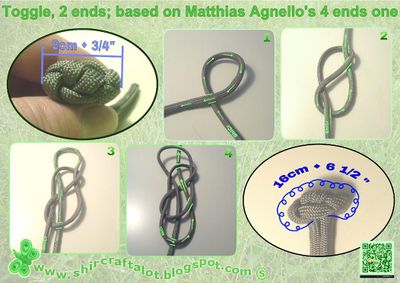Closures
When making pieces, in particular bracelets and necklaces, there are a variety of methods to finish the design for use. JD Lenzen is a proponent of a "pure cord" philosophy, so his original designs are almost always made with a knot-and-loop closure. Traditionally and most simply, the knot is a simple overhand, but more frequently he has been using a two-strand diamond knot. Look at almost any of his bracelet videos on Youtube, and you'll get a great tutorial in that knot.
Many people prefer a buckle, for a more secure fit and a little less bulky under shirt cuffs. Adding a buckle to designs with core cords is generally pretty simple. Using the "Coop Method" (commonly seen on MrCoop's Youtube videos), you fuse the cords together if using two colors, then tie a cow hitch on one buckle end, run the cords through the other buckle and begin your design from the second buckle, ending close to the cow hitch. If the design doesn't have core cords, it is sometimes possible to tie around cores anyway, although this does add bulk to the design. Alternatively, you can just tie from one buckle, then when you get to the end you'll bring the cords through the second buckle, and tie some knot to hold them in place. Some people use a square knot (as seen in Solomon bar designs), others use a snake knot. Experiment and see what works for your design and aesthetic sense.
Some people have put some effort into documenting pure-cord terminal knots that are more involved than a diamond knot.
Here is a simple method to make an asymmetric knot, to be used like a toggle at the end of a cord, courtesy of Shirley De Schutter. Tighten carefully and evenly, or you'll end up with a mess (click image for full-size).
